The Tether Challenge ended just about a half-hour ago and NASA’s Prize money for the Tether Challenge is safe for another year.
Four teams entered the competition; Astroaraneae, UBC, Centaurus Aerospace and Bryan Laubscher. Lots were drawn to determine who would face who in the two semi-final qualifying matches. Centaurus Aerospace drew Astroaraneae and UBC drew Bryan Laubscher.
Tethers from Centaurus Aerospace and Astroaraneae were both weighed and both came in under the 2 gram limit. They were each then mounted on the Tether Pull machine and measured for length. While Astroaraneae met the 2 meter minimum, Centaurus Aerospace did not and was disqualified.
Tethers from UBC and Bryan Laubscher were then both weighed and they, too, both came in under the 2 gram limit. They were each then mounted on the Tether Pull machine and measured for length. Unfortunately, neither team met the 2 meter minimum and were both, therefore, disqualified. So, Team Astroaraneae won the competition by default.
There was much discussion and unhappiness over the disqualifications, and that topic deserves a separate post.
in the spirit of competition, however, tethers from UBC and Bryan Laubscher were matched against each other in a “non-title” match. Team UBC won when Bryan’s tether parted at 531 pounds. UBC then matched it’s tether against one from Centaurus Aerospace in another friendly competition. Centaurus won when the UBC tether parted at about 880 pounds.
Astroaraneae then faced off against the house tether. The house tether won, but the Astroaraneae tether didn’t part until 1335.9 pounds of pressure was applied – a very impressive performance. This beat last year’s winner by about 100 pounds.
An attempt was then made to break the house tether. It was matched against a high-quality rope, not as competition, but just to see at what level the house tether parted at. This number would then be a factor in next year’s competition. Unfortunately, the house tether proved to be stronger than the machine! The aluminum rollers holding the tethers actually began to force the block holding them outward at one end and the measurement had to be halted. They’re going to have to come up with an alternative method to measure these.
So, congratulations go out to Michael Remington and his Team Astroaraneae! Michael and his team promise to be back next year with an even stronger composition.
Below are some pictures of the Tether Challenge. As always, click on the thumbnails to view a larger version of the picture.
 Ben Shelef explaining the rules before competition began.
Ben Shelef explaining the rules before competition began.
 Ben hooking up the signal lights. These lights were “on” for each tether during the pull. When a tether broke, it’s light would go out – the other light signifying the winner.
Ben hooking up the signal lights. These lights were “on” for each tether during the pull. When a tether broke, it’s light would go out – the other light signifying the winner.
 The “Tether Torture Machine” after being beaten by the House Tether. Note the block holding the left side of the roller – it’s being forced outward. Not good !
The “Tether Torture Machine” after being beaten by the House Tether. Note the block holding the left side of the roller – it’s being forced outward. Not good !
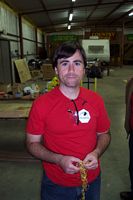 Michael Remington of Team Astroaraneae. Congratulations again !!
Michael Remington of Team Astroaraneae. Congratulations again !!

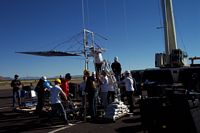
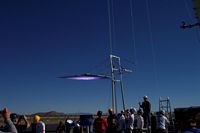
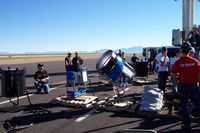
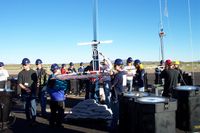
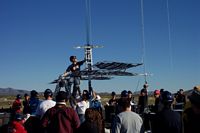
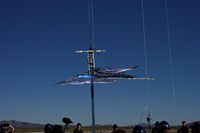
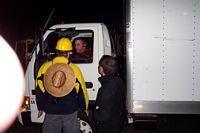
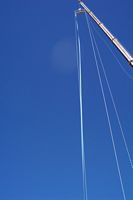
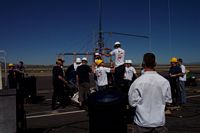


 MClimber became the first team to attempt a run today, and they succeeded in making it all the way to the top of the 200 foot-tall tether. It took them 6 minutes and 40 seconds to complete the run, and the rules state that you have to do it in one minute or less. So, the success is partial – they got to the top, but not in the required time (and thus are not eligible for the prize with this run). But it’s incredible that they made it all. The tether was twisting tremendously and the solar array was continuously in and out of the best optical position. They are now going over their “lessons learned” and I expect them to make another attempt tomorrow.
MClimber became the first team to attempt a run today, and they succeeded in making it all the way to the top of the 200 foot-tall tether. It took them 6 minutes and 40 seconds to complete the run, and the rules state that you have to do it in one minute or less. So, the success is partial – they got to the top, but not in the required time (and thus are not eligible for the prize with this run). But it’s incredible that they made it all. The tether was twisting tremendously and the solar array was continuously in and out of the best optical position. They are now going over their “lessons learned” and I expect them to make another attempt tomorrow.

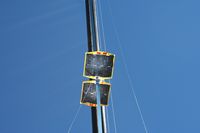
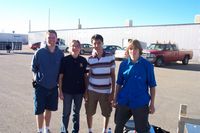

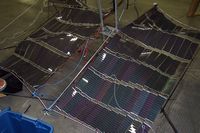


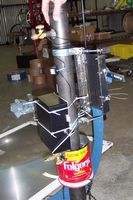
 Well, today is the day. Things are behind, but moving along. UBC-Snowstar is now on the tether and should be attempting it’s first climb shortly. I understand this is being simultaneously webcast, so you should be able to go to
Well, today is the day. Things are behind, but moving along. UBC-Snowstar is now on the tether and should be attempting it’s first climb shortly. I understand this is being simultaneously webcast, so you should be able to go to 
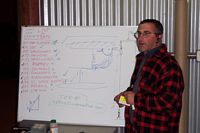
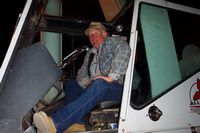
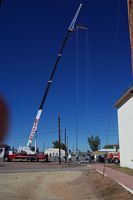

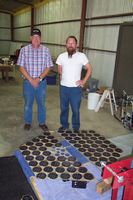
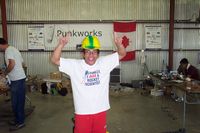
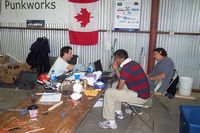
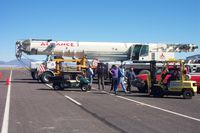
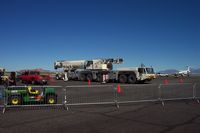
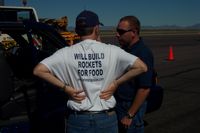
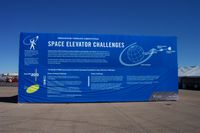
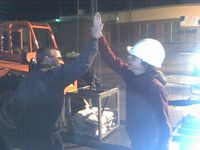
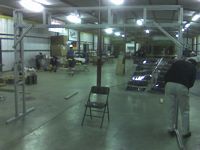




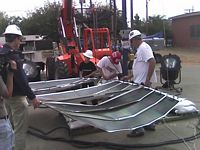

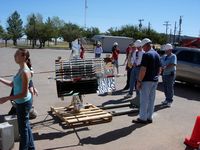

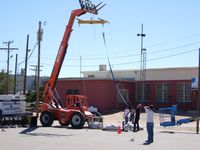
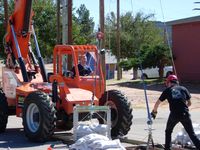
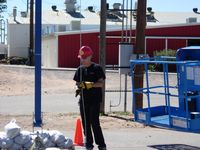


 On their blog, Team Starclimber
On their blog, Team Starclimber  The Kansas City Space Pirates were the first team to attempt to qualify their Climber for the 2006 Space Elevator Games. Unfortunately, while their climber did make it to the top and within the allotted time, it failed to descend properly and had to be hauled down. Nevertheless, the fact that they made it to the top is quite encouraging. I talked to their team captain, Brian Turner, and he told me that they knew what the problem was, were in the process of fixing it, would be ready to make another attempt in the morning, and still hoped to be first to qualify. Below is a thumbnail version of a picture of their climber sitting at the top of the test tether. Click on it to get a larger version and double-click on the arrow next to the speaker icon to hear my brief interview with him as he discusses their results.
The Kansas City Space Pirates were the first team to attempt to qualify their Climber for the 2006 Space Elevator Games. Unfortunately, while their climber did make it to the top and within the allotted time, it failed to descend properly and had to be hauled down. Nevertheless, the fact that they made it to the top is quite encouraging. I talked to their team captain, Brian Turner, and he told me that they knew what the problem was, were in the process of fixing it, would be ready to make another attempt in the morning, and still hoped to be first to qualify. Below is a thumbnail version of a picture of their climber sitting at the top of the test tether. Click on it to get a larger version and double-click on the arrow next to the speaker icon to hear my brief interview with him as he discusses their results.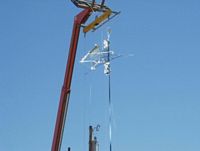
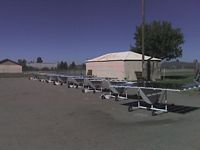


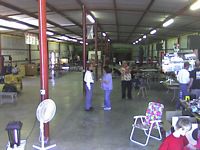
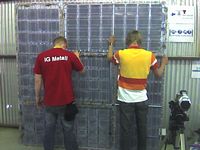
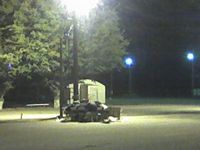
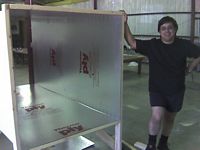
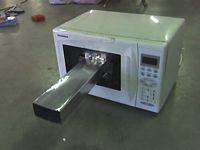
 Good
Good 
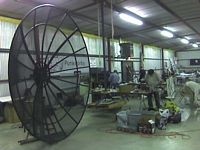



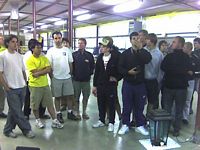

 I had a short conversation yesterday with Vince Lopresti of the Dallas SpaceMiners Team. By the time you’re reading this, he should be in Las Cruces with two complete Climbers and parts for third. Listen to what Vince has to say about the competition and his chances by double-clicking the arrow to the right of the speaker, below.
I had a short conversation yesterday with Vince Lopresti of the Dallas SpaceMiners Team. By the time you’re reading this, he should be in Las Cruces with two complete Climbers and parts for third. Listen to what Vince has to say about the competition and his chances by double-clicking the arrow to the right of the speaker, below. And, on a happy note, Team TurboCrawler (the German Team) had their equipment clear customs and arrive today, onsite. So, we should have the benefit of their best efforts.
And, on a happy note, Team TurboCrawler (the German Team) had their equipment clear customs and arrive today, onsite. So, we should have the benefit of their best efforts.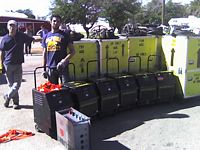
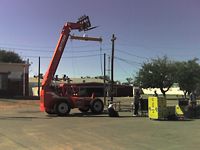

 Ben Shelef reports that “things are good” – the rain has stopped. Two other teams have now arrived onsite; Starclimber and the University of Saskatchewan Space Design Team (USST).
Ben Shelef reports that “things are good” – the rain has stopped. Two other teams have now arrived onsite; Starclimber and the University of Saskatchewan Space Design Team (USST).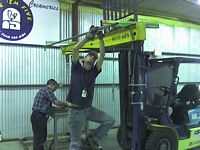
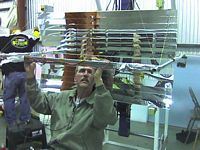
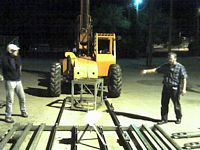


 Still no news on the German team’s TurboCrawler lifter. It appears that we can’t even find out whether or not their Lifter has been released from Customs or not. So, we don’t know if it is actually on the last leg of its journey to Las Cruces or still stuck in LA Customs. Without knowing all the ins and outs of the situation, its hard to make a definitive judgment on why this snafu occurred, but it certainly doesn’t reflect well on our country’s hospitality (or our competence). If the Lifter isn’t released until Monday, it won’t make it to Las Cruces until the last possible moment, giving the Germans almost no time to get it in the shape they want for the competition.
Still no news on the German team’s TurboCrawler lifter. It appears that we can’t even find out whether or not their Lifter has been released from Customs or not. So, we don’t know if it is actually on the last leg of its journey to Las Cruces or still stuck in LA Customs. Without knowing all the ins and outs of the situation, its hard to make a definitive judgment on why this snafu occurred, but it certainly doesn’t reflect well on our country’s hospitality (or our competence). If the Lifter isn’t released until Monday, it won’t make it to Las Cruces until the last possible moment, giving the Germans almost no time to get it in the shape they want for the competition. One other note; the USST team called the Elevator2010 crew today and said that they were crossing Wisconsin on the way to Las Cruces. This means that they’ve made it past Customs at the US – Canadian border and so, presumably, will arrive on time and intact.
One other note; the USST team called the Elevator2010 crew today and said that they were crossing Wisconsin on the way to Las Cruces. This means that they’ve made it past Customs at the US – Canadian border and so, presumably, will arrive on time and intact.



 Here’s an
Here’s an  It’s starting to happen! The Elevator2010 team is now on the road to Las Cruces and should be arriving tomorrow, Friday, around noon. Others are also beginning to converge; the Kansas City Space Pirates are on site and the German Team (TurboCrawler) should also be there by now.
It’s starting to happen! The Elevator2010 team is now on the road to Las Cruces and should be arriving tomorrow, Friday, around noon. Others are also beginning to converge; the Kansas City Space Pirates are on site and the German Team (TurboCrawler) should also be there by now. The Snowstar team is officially
The Snowstar team is officially 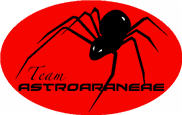 Only 10 more days until the start of the Space Elevator Games. I’m not associated with any of the Climber or Tether teams, but I can imagine the frantic pace they’re working at now to finalize their entries.
Only 10 more days until the start of the Space Elevator Games. I’m not associated with any of the Climber or Tether teams, but I can imagine the frantic pace they’re working at now to finalize their entries.  A two-gram “House tether” may be used as one of the competitors in order to create evenly numbered brackets. This depends on how many competitors show up. If there are four entries (a distinct possibility), they’ll be divided into two brackets of two each to compete, with the two winners competing against each other for the right to compete for a chance to win the prize.
A two-gram “House tether” may be used as one of the competitors in order to create evenly numbered brackets. This depends on how many competitors show up. If there are four entries (a distinct possibility), they’ll be divided into two brackets of two each to compete, with the two winners competing against each other for the right to compete for a chance to win the prize. The plan is to increase the strength requirements each year (as well as including new requirements when appropriate). Teams know this; Patrick Littlejohn of Team Snowstar states; “The Snowstar Tether group has been working since January 2006, with an emphasis on extensive testing in order to get the best results out of conventional materials. As the competition progresses through 2010, we hope to incorporate more and more next gen materials into our research and development until one day a working elevator is a reality. If we win, we will be throwing one hell of a party.”
The plan is to increase the strength requirements each year (as well as including new requirements when appropriate). Teams know this; Patrick Littlejohn of Team Snowstar states; “The Snowstar Tether group has been working since January 2006, with an emphasis on extensive testing in order to get the best results out of conventional materials. As the competition progresses through 2010, we hope to incorporate more and more next gen materials into our research and development until one day a working elevator is a reality. If we win, we will be throwing one hell of a party.”